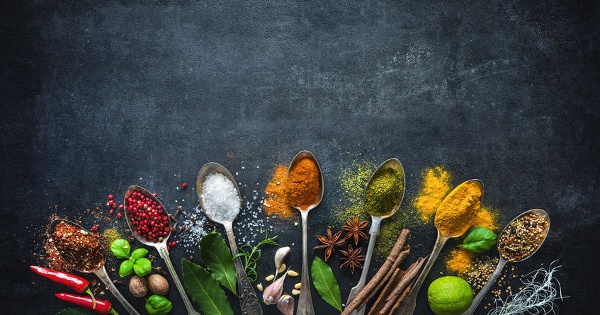Five Herbs and Spices to Turn Ordinary Meals into ‘Supermeals’
Written by: GreenMedInfo Research Group [2]
Incorporating these five herbs and spices into your daily diet may reduce the risk of cardiovascular disease, protect your brain from neurodegeneration, stimulate your immune system and protect against inflammation, among other benefits. Best of all, these ingredients are all easily available and may already exist in your pantry or spice rack
Over the years, researchers have become increasingly interested in the effects of diet and natural compounds on human health, finding that many herbs and spices [3] are equally or more effective than many conventional medicines and treatments, and often present far fewer adverse effects while being more cost-effective. Here are five herbs and spices you can add to your diet to turn ordinary meals into nutrient-dense “supermeals”:
1. Garlic
Garlic [4], a member of the Allium family, is known for its anti-inflammatory effects, but recent research has found that garlic has immunoregulation properties that fight against the development of conditions like obesity, cardiovascular disease [5]and cancer [6].[i] [7] Garlic’s strong immunostimulation effects work by modulating cytokine secretion and directly stimulating immune cells, promoting efficient cellular response to viral infections and other diseases.[ii] [8]
Additional research on the benefits of garlic for cardiovascular disease prevention and therapy shows that garlic intake increases fibrinolytic activity in both healthy patients and those who have had a heart attack, reducing the risk of a blood clot.[iii] [9] Garlic also works to decrease serum lipids levels and blood pressure, both of which are associated with cardiovascular disease.[iv] [10],[v] [11]
Finally, multiple studies show that garlic may also prevent neurodegenerative disease progression. Garlic’s neuroprotective effects are probably due to its antioxidant, anti-apoptotic and anti-atherogenic benefits, which work together to prevent the risk of diseases like Alzheimer’s [12], Parkinson’s [13], Huntington’s [14] and motor neuron diseases.[vi] [15]
2. Ginger
Even among lay individuals, ginger [16] is well-known for its gastrointestinal benefits and is widely used as a natural remedy for stomachache, nausea, vomiting, belching, diarrhea [17] and other gastric ailments, including irritable bowel syndrome.[vii] [18]
Ginger and its metabolites accumulate in the digestive tract, which explains its potent digestive benefits, but research has demonstrated that ginger’s therapeutic potential extends beyond its gastrointestinal benefits.[viii] [19]
Several of the biological constituents of ginger [16], including gingerol [20] and zingerone, may reduce the risk of various types of cancer via their anti-tumor properties and antioxidant activity.[ix] [21] By up-regulating the tumor repression gene, these biological constituents can inhibit tumor growth or even prevent their occurrence.
These findings have been demonstrated for both breast and prostate cancers, but researchers believe that ginger may be a novel therapeutic approach to preventing and treating a variety of cancers, with fewer side effects than the conventional treatment methods such as chemotherapy or radiotherapy drugs.[x] [22]
3. Turmeric
Like ginger, the benefits of turmeric [23] and its main constituent curcumin are well-known. Curcumin has been studied extensively for its antimicrobial, anti-inflammatory and antioxidant properties, and researchers have demonstrated that turmeric supplementation may prevent cardiovascular disease and produce neuroprotective effects.[xi] [24]
Because of its anti-inflammatory effects, curcumin [25] is a potential treatment for inflammatory bowel disease, pancreatitis, arthritis and breast and prostate cancers.[xii] [26],[xiii] [27] Additionally, curcumin boasts neuroprotective properties and may reduce the risk or delay the development of Alzheimer’s, multiple sclerosis, prion diseases, Down syndrome and autism.[xiv] [28]
While adverse effects associated with the consumption of curcumin or turmeric are rare, the bioavailability of curcumin does present some challenges. By combining turmeric with black pepper, which contains the alkaloid piperine, it’s possible to increase the absorption rate of curcumin.[xv] [29],[xvi] [30]
4. Chili Pepper
Capsaicin [31], a phytochemical in chili peppers that impacts the spiciness, is known for promoting vascular health, as well as improving metabolic syndrome, diabetes, obesity and stroke risk.[xvii] [32],[xviii] [33]
Capsaicin’s effects on these diseases seem to be multifaceted: for example, while a reduction of obesity decreases the risk of cardiovascular disease, capsaicin also works to improve coronary blood flow, improving overall heart health. Also, capsaicin’s antimicrobial properties seem to positively impact the health of the gut microbiome, indirectly improving the risk of metabolic syndrome.[xix] [34]
In addition to these benefits, researchers believe that the consumption of chili peppers could drastically improve micronutrient deficiency.[xx] [35] Micronutrients such as vitamins, minerals, antioxidants and trace elements are severely lacking from the global diet and are necessary for the prevention of various diseases, healthy early childhood development, and the breakdown and absorption of macronutrients.[xxi] [36] Micronutrients contained in chili peppers include:[xxii] [37]
|
Vitamin A |
Vitamin C |
|
Vitamin E |
Magnesium |
|
Folate |
Potassium |
|
Copper |
Manganese |
|
Molybdenum |
Iron |
Micronutrients cannot be synthesized by the human body and must be obtained through diet, and researchers have been impressed with the potency and high number of these compounds in chili peppers, reporting, “Significant portions of recommended daily nutrients could be supplied by the incorporation of nutrient‐rich chili pepper into human diets.” [xxiii] [38],[xxiv] [39]
5. Saffron
Saffron [40], like turmeric, is a golden spice with therapeutic properties, although it is less well-known. Saffron has been studied for its beneficial effects on gastrointestinal diseases, the gut microbiome, the stomach, hepatitis, colitis and cancer, among other disorders.[xxv] [41]
In addition to these benefits, saffron may be a beneficial natural treatment for mild to moderate depression, and in one study was equally effective as popular antidepressant drugs imipramine and fluoxetine.[xxvi] [42]
While researchers aren’t sure exactly how saffron produces these effects, it seems that saffron increases mood-elevating chemicals like serotonin in the brain by inhibiting serotonin reuptake, keeping serotonin levels high and prolonging serotonin’s positive effects.[xxvii] [43]
Adding these five herbs and spices to your daily cooking routine is the easiest way to procure their benefits. By sprinkling on your roasted vegetables, adding to smoothies or shakes, or including them in your marinades and dressings, you can drastically increase the nutritional content of your everyday meals.
To learn more about the potent benefits of these ingredients and others in your pantry, visit the GreenMedInfo research database [3] on culinary herbs and spices.
Read the full article at GreenMedInfo.com [45].
This article is copyrighted by GreenMedInfo LLC, 2020
© June 17, 2020 GreenMedInfo LLC. This work is reproduced and distributed with the permission of GreenMedInfo LLC. Want to learn more from GreenMedInfo? Sign up for the newsletter here //www.greenmedinfo.com/greenmed/newsletter [46].
References
[i] [47] J Immunol Res [48]. 2015; 2015: 401630.
[ii] [49] J Immunol Res [48]. 2015; 2015: 401630.
[iii] [50] Avicenna J Phytomed [51]. 2014 Jan-Feb; 4(1): 1-14.
[iv] [52] Evid Based Complement Alternat Med [53]. 2013; 2013: 125649.
[v] [54] Indian J Clin Biochem [55]. 2011 Jan; 26(1): 96-97.
[vi] [56] Libyan J Med [57]. 2008; 3(1): 23-33.
[vii] [58] Food Sci Nutr [59]. 2019 Jan; 7(1): 96-108.
[viii] [60] Bode AM, Dong Z. Herbal Medicine: Biomolecular and Clinical Aspects [61]. 2nd edition. Boca Raton (FL): CRC Press/Taylor & Francis; 2011. Chapter 7
[ix] [62] Int J Physiol Pathophysiol Pharmacol [63]. 2014; 6(2): 125-136.
[x] [64] Int J Physiol Pathophysiol Pharmacol [63]. 2014; 6(2): 125-136.
[xi] [65] Adv Biomed Res [66]. 2018; 7: 38.
[xii] [67] AAPS J [68]. 2013 Jan; 15(1): 195-218.
[xiii] [69] Altern Med Rev [70]. 2009 Jun;14(2):141-53.
[xiv] [71] Biofactors [72]. 2019 Sep;45(5):666-689. doi: 10.1002/biof.1533. Epub 2019 Jun 11.
[xv] [73] AAPS J [68]. 2013 Jan; 15(1): 195-218.
[xvi] [74] Foods [75]. 2017 Oct; 6(10): 92.
[xvii] [76] PLoS One [77]. 2017; 12(1): e0169876.
[xviii] [78] Open Heart [79]. 2015; 2(1): e000262.
[xix] [80] PLoS One [77]. 2017; 12(1): e0169876.
[xx] [81] Food Sci Nutr [82]. 2018 Nov; 6(8): 2239-2251.
[xxi] [83] Food Sci Nutr [82]. 2018 Nov; 6(8): 2239-2251.
[xxii] [84] Food Sci Nutr [82]. 2018 Nov; 6(8): 2239-2251.
[xxiii] [85] PLoS One [86]. 2016; 11(8): e0161464.
[xxiv] [87] Food Sci Nutr [82]. 2018 Nov; 6(8): 2239-2251.
[xxv] [88] Nutrients [89]. 2019 May; 11(5): 943.
[xxvi] [90] Pharmacogn Rev [91]. 2013 Jan-Jun; 7(13): 61-66.
[xxvii] [92] J Pharm Bioallied Sci [93]. 2018 Oct-Dec; 10(4): 173-180.
The GMI Research Group (GMIRG) is dedicated to investigating the most important health and environmental issues of the day. Special emphasis will be placed on environmental health. Our focused and deep research will explore the many ways in which the present condition of the human body directly reflects the true state of the ambient environment.
Disclaimer: This article is not intended to provide medical advice, diagnosis or treatment. Views expressed here do not necessarily reflect those of GreenMedInfo or its staff.

See Also:
Understand the Times We are Currently Living Through
Exposing the Christian Zionism Cult [94]
Insider Exposes Freemasonry as the World’s Oldest Secret Religion and the Luciferian Plans for The New World Order [95]

Identifying the Luciferian Globalists Implementing the New World Order – Who are the “Jews”? [96]
Who are the Children of Abraham? [97]
The Brain Myth: Your Intellect and Thoughts Originate in Your Heart, Not Your Brain [98]
Fact Check: “Christianity” and the Christian Religion is NOT Found in the Bible – The Person Jesus Christ Is [99]
Young Man Living on the Streets Finds Jesus of the Bible – Overcomes Drug and “Terminally Online” Addictions [100]
COVID “Vaccine” Injured Muslim Man Learns COVID was a Scam and Meets Jesus of the Bible as he Begins to Heal [101]
Was the U.S. Constitution Written to Protect “We the People” or “We the Globalists”? Were the Founding Fathers Godly Men or Servants of Satan? [102]
The Seal and Mark of God is Far More Important than the “Mark of the Beast” – Are You Prepared for What’s Coming? [103]
The United States and The Beast: A look at Revelation in Light of Current Events Since 2020 [104]
The Satanic Roots to Modern Medicine – The Mark of the Beast? [105]
Medicine: Idolatry in the Twenty First Century – 8-Year-Old Article More Relevant Today than the Day it was Written [106]
 [107]
[107]
Having problems receiving our emails? See:
How to Beat Internet Censorship and Create Your Own Newsfeed [108]
We Are Now on Telegram [109]. Video channels at Bitchute [110], and Odysee [111].
If our website is seized and shut down, find us on Telegram [109], as well as Bitchute [110] and Odysee [111] for further instructions about where to find us.
If you use the TOR Onion browser [112], here are the links and corresponding URLs to use in the TOR browser [112] to find us on the Dark Web: Health Impact News [113], Vaccine Impact [114], Medical Kidnap [115], Created4Health [116], CoconutOil.com [117].















